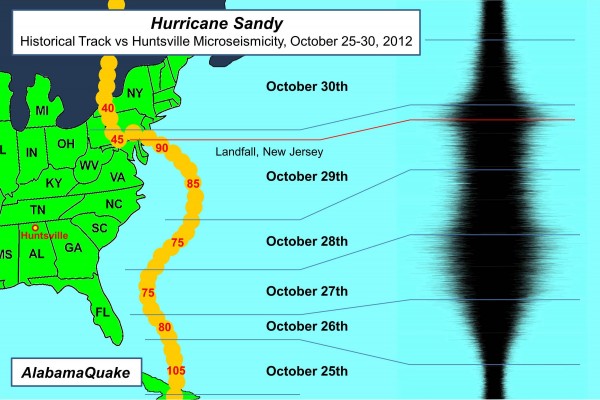Hurricane Sandy and Huntsville Microseismicity
From Steve Jones with https://www.alabamaquake.com…
Microseisms are the ever-present “background noise” of the earth, caused primarily by the action of ocean currents and waves against coastlines the world over. A landfalling hurricane produces high coastal winds and waves that can cause an increase in the level of microseismicity seen at locations well inland from the coast.
As Hurricane Sandy recently approached the United States mainland in a northward track that crossed over eastern Cuba, the Huntsville microseismicity changes attributed to the storm were recorded at AlabamaQuake beginning on Thursday October 25th. On Friday the 26th, the microseismicity began to grow, even though the storm’s wind speed was dropping somewhat, as the storm moved closer to South Florida. On October 27th, microseismicity continued to grow as windspeed dropped to 75mph and the storm center moved nearer to coastal Georgia, slightly closer to Huntsville. As the winds were maintained at 75mph and the storm continued its northward track over the waters of the Atlantic Ocean off the east coast of the US, the microseismicity decreased slightly, and remained at the same approximate level as the winds increased again early on the 29th, while the storm continued moving farther from the coastal regions nearest to Huntsville.
Late on October 29th, with the storm winds increased notably, the circulation center moved onshore at landfall in New Jersey and the Huntsville microseismicity again peaked, probably due to the extremely high wind and surf along the coast. Following landfall, the microseismicity dropped as the storm, now over land, decreased its high wind and waves impact on the US coastline. With the storm’s energy dissipating over the northeast US and southern Canada, the ground noise level began returning to more normal “pre-Sandy” levels.
Category: Hodgepodge


















